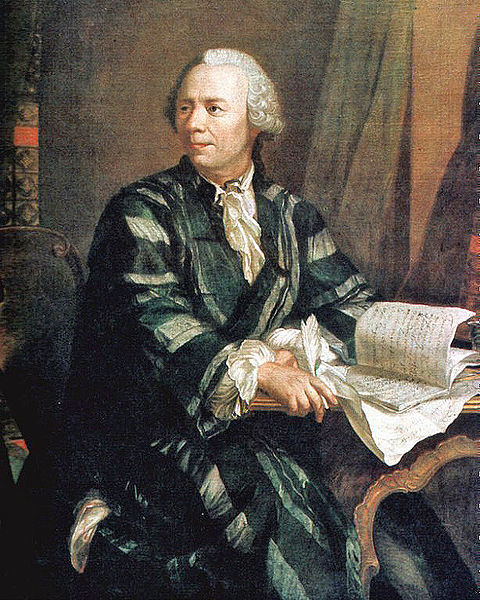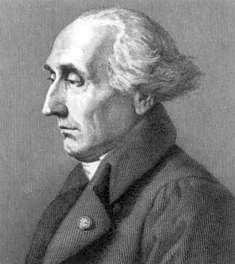

In contrast to temperature or salinity, which can each be described by a single quantity, currents are only fully described through two quantities, such as east and north components, or speed and direction.
Ocean properties such as temperature and salinity are called scalars, ocean properties such as currents are called vectors.This exercise demonstrates various ways to display vectors in graphs and maps.
Vectors can be displayed in two fundamentally different ways. Both were developed at nearly the same time during the 18th century.
The first method was developed by Leonhard Euler and is now known as the Eulerian approach.
Leonhard Euler

one of the greatest European mathematicians, was born on 15 April, 1707 in Basel, Switzerland. He became an associate of the St. Petersburg Academy of Sciences at the age of 20 and professor six years later (he succeeded Daniel Bernoulli in the chair of mathematics) in 1733.
Working long and late hours made him loose the sight of one eye in 1735. In 1741 he moved to Berlin to become a member of the Berlin Academy, but in 1766 he left the employment of Frederick the Great to return to Catharina II in St. Petersburg. He soon lost the sight of his other eye and from then on developed his many theorems and theoretical works, such as his theory of lunar motion of 1772, doing all calculations in his head.
Euler died in St. Petersburg on 18 September, 1783. He left 856 books and articles, most of them in Latin, on subjects from general calculus to problems of mechanics, optics, acoustics and astronomy. Russia's strong mathematical tradition has its origins in Euler's work during his residence in St. Petersburg.
An alternative approach was followed by Joseph Louis Lagrange and has become known as the Lagrangian approach.
Joseph-Louis Lagrange

was one of the greatest European mathematicians. Born on 25 January, 1736 as Guiseppe Luigi Lagrangia in Turin (in today's Italy but during the 18th century under French rule), he was teaching mathematics as a military instructor before he turned 20. He began publishing theoretical works on sound propagation, on the movement of the moon and on problems of calculus and was soon considered one of the greatest living mathematicians.
The Paris Academy of Sciences regularly offered prizes for essays on selected difficult problems. Lagrange was awarded the prize in 1764, 1766, 1772, 1774 and 1778. Euler recommened Lagrange as his successor when he left Berlin in 1766.
Lagrange worked in Berlin until the death of Frederick the Great in 1787. He then moved to Paris, following an invitation of Louis XVI. During the French Revolution he served on the committee for a metric system of units and became the first professor of mathematics at the École Polytechnique when it opened in 1795. Napoleon honoured Lagrange by making him a senator and a count of the empire.
Lagrange died in Paris on 10 April, 1813. He left a wealth of articles and books, most of them in French, on subjects as various as the principles of mechanics, the theory of analytic functions, prime-number theory and generalized coordinates. The equations which form the basis for classical mechanics now bear his name.
This exercise explores both possibilities, the "Eulerian" approach and the "Lagrangian" approach at displaying vectors in graphs.